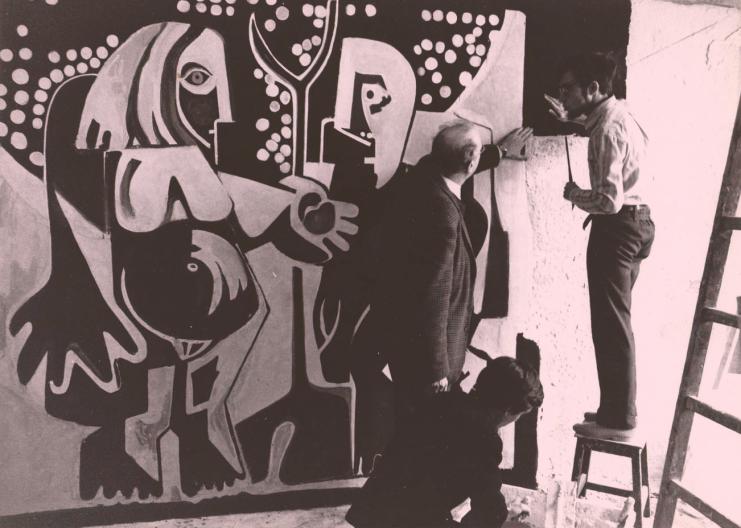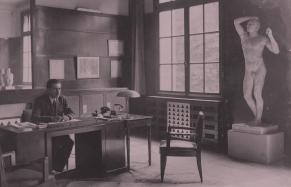History

A unique teaching method - an interdisciplinary approach combining ten creation departments -, an outward looking attitude stemming from numerous partnerships with the best universities, leading cultural institutions and cutting-edge companies; all of which place the École nationale supérieure des Arts Décoratifs among the few leading art and creation schools.
The School
The École nationale supérieure des Arts Décoratifs has always played a significant role in the history of creation, decorative arts and then of design in France. Many renowned figures appear among the list of its graduates.
It was first founded in 1766 by painter Jean-Jacques Bachelier as the École royale gratuite de dessin (the Royal Free School of Drawing) but officially opened its doors in 1767 thanks to letters patent issued by Louis XV. It originally aimed to develop crafts relating to the arts so as to improve the quality of handcrafted and manufactured goods.
After several designation changes, the School became the École nationale des arts décoratifs in 1877 before taking its current name, the École nationale supérieure des arts décoratifs, in 1925. It welcomed and trained prominent architects like Charles Garnier, sculptors like Auguste Rodin or painters like Henri Matisse.
The interwar period was one of great success: whether modern classicists or modernists, teachers (Éric Bagge, Gustave Jaulmes, etc) and former students (Maurice Dufrène, Jean Burkhalter, Jean et Joël Martel, Raymond Subes, etc) significantly contributed to the international exhibitions of 1925 and 1937. The School started including new fields in its academics, in particular graphic arts: in 1932, Cassandre created a free course on advertising posters. The School even used to issue its own architecture diploma, which was created in 1922 but later abolished in 1941.
After the Second World War, Léon Moussinac, then director of the School, placed interior architecture back at the center of the courses. A great number of creators, such as Pierre Gautier-Delaye or Joseph-André Motte, contributed to the living environment transformations of the Glorious Thirty.
In 1962, Jacques Adnet, Moussinac’s successor, asked Roger Tallon to implement what was then still called “industrial aesthetics”; it eventually became the first industrial design course ever taught in France.
In 1966, Jean Widmer also made similar changes in graphic arts, which became visual communication.
Other major transformations occurred in the late 1960s and early 1970s.
When Michel Tourlière directed the School, many fields became increasingly important while others emerged: fashion design, textile, photography, stage design, video, furniture and computer graphics.
Richard Peduzzi was director of the School from 1990 to 2002. The institution developed its job-oriented approach and was one of the first art schools to ever include multimedia in its courses, thus foreseeing the digital revolution.


In the last few years
In 2010, the École des Arts Décoratifs’s diploma was granted the Master’s degree, which completed the reform designed for the School to be in line with the Bologna process - the European harmonization of higher education degrees into a three-cycle model (Bachelor’s Master’s doctorate).
In 2011, the School became a partner of the Université Paris Sciences et Lettres (PSL).
In 2012, the School created SACRe, a practice-based art doctorate program, along with the ENS, the CNSAD and the École des Beaux-Arts. That same year, the École des Arts Décoratifs became a member of the Conférence des Grandes Écoles.
Emmanuel Tibloux has been director of the École nationale supérieure des Arts Décoratifs since 2018.
Ministry of Culture
The purpose of the School is: ”the artistic, scientific and technical training of creators who are capable of designing and developing any creative work in all fields of the decorative arts, as well as to run and promote research conducted in those fields.” (Article 2, statuary decree of 30 October 1998).
The School has been located rue d’Ulm since 1928. The premises have entirely been modernized by architect Luc Arsène-Henry, designer Philippe Starck and landscaper Pascal Cribier. The modernization undertaking, which was completed in 2004, gave the School a powerful architectural image and definitely settled it on its historical location, inextricably linked to the Montagne Sainte-Geneviève, at the heart of Paris.
Innovation and research
The École nationale supérieure des Arts Décoratifs has been developing an ambitious research policy along with EnsadLab - its research laboratory.
EnsadLab is a specific research center which reflects on programs relating to the creation, design and innovation fields, whether known or emerging, in relation to the social, economic, technological, political, industrial and cultural contexts of the modern world.
Since 2011, the School has been a partner of the Université Paris Sciences et Lettres (PSL) which includes 25 high education and research institutions (Collège de France, ENS, ESPCI, Observatoire de Paris, Institut Curie, Université Paris-Dauphine, Ehess...).
Alumni
Among the School’s former students of the last decades are numerous renowned figures such as Philippe Apeloig, Pénélope Bagieu, Mohamed Bourouissa, Ronan Bouroullec, Claude Closky, Nathalie Crinière, Philippe Cazal, Céline Devaux, Hervé Di Rosa, Jean-Paul Goude, Camille Henrot, Pierre Huyghe, Benjamin Lacombe, Annette Messager, Ariane Michel, Pascal Mourgue, Michel Ocelot, Anne et Patrick Poirier, Anri Sala, Jérôme Savary, Jacques Tardi, Xavier Veilhan, Martin Veyron, Yiqing Yin, etc.